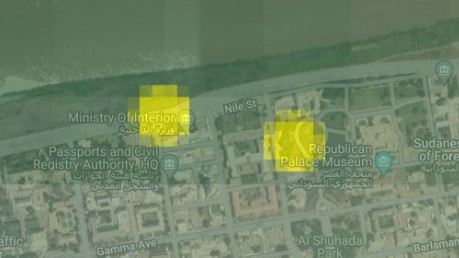Sudan crisis: Did the army really destroy Khartoum's Republican Palace?

Earlier this week, the Rapid Support Forces (RSF) paramilitary claimed the Sudanese army had "launched air raids on the Republican Palace, resulting in its complete destruction".
Khartoum has two Republican Palaces, next to one another. The original is Ottoman-Egyptian, begun in 1825, four years after their occupation of Sudan. Overlooking it is a far larger structure built in 2015 under then-president Omar al-Bashir.
If it is true that one of these palaces on the Blue Nile had been completely destroyed, the war - raging now for nearly a month - would have wiped one of Khartoum's most recognisable landmarks from the map. But evidence suggests neither building was razed. Yet they have been attacked nonetheless.
A photograph taken by drone by photographer Abd Almohimen Sayed, which he shared online on Wednesday, showed both palaces very much standing. Scorch marks can be seen around windows on the top floor and heavy damage on the western facade of the modern palace.
Video footage has also circulated online, showing considerable damage to the walls around its western entrance.
New MEE newsletter: Jerusalem Dispatch
Sign up to get the latest insights and analysis on Israel-Palestine, alongside Turkey Unpacked and other MEE newsletters
Middle East Eye also reviewed images from the Suomi NPP Satellite provided by Soar, which show on 9 May thermal anomalies over two locations in Khartoum: one next to the interior ministry to the west of the old Republican Palace, and another just south of it.
These thermal anomalies could indicate fires when the satellite snapped the image.
The Republican Palace is situated close to significant landmarks, including ministries, the armed forces' headquarters and vital bridges connecting Khartoum to other regions.
These sites are witnessing ongoing fighting, which has claimed the lives of more than 600 people and displaced 700,000 since the conflict began on 15 April.
Sources on the ground confirmed to MEE that smaller administrative buildings on the site had been damaged by bombing, with the newer, 25,000-square metre Republican Palace hit worst of all.
Built with China funding 40 percent of its costs, the new Republican Palace became the site of Bashir's office and cabinet when completed. It is reported to have tunnels and secret rooms, and has traditionally been protected by Sudan's Republican Guard.
But after the fall of Bashir in April 2019, the RSF took control of the site.
The RSF, led by Mohamed Hamdan Dagalo, a general commonly known as Hemeti, has been locked in conflict with the Sudanese military after tensions over plans to merge the two boiled over into violence.
Since the start of the conflict, the Republican Palace site has been held by the RSF, with Hemeti rumoured to have sheltered there, as he was seen entering it in the early days of the fighting. In the recent footage reviewed by MEE, no RSF presence can be seen.
Sources in Khartoum told MEE that the army and Central Reserve Police force had besieged the area. Sudanese military planes have launched heavy air strikes on RSF positions, with the paramilitary attempting to bed into urban areas.
There also appears to be some minimal damage to the old palace, which was partly built with stones from the ancient city of Soba.
In 1885, followers of Muhammad Ahmad bin Abd Allah famously killed the British major-general Charles George Gordon on the Republican Palace's stairs.
Gordon had been deployed to Khartoum to lead an evacuation during the Mahdist revolution and stayed to defend the city. The death of "Gordon Pasha" and the fall of Khartoum marked the end of Ottoman-Egyptian rule in Sudan.
Middle East Eye delivers independent and unrivalled coverage and analysis of the Middle East, North Africa and beyond. To learn more about republishing this content and the associated fees, please fill out this form. More about MEE can be found here.





